

Last updated on

Utilize these three critical GA4 reports to align your 2024 SEO strategy with your business objectives and uncover optimization opportunities. We started discussing GA4 in 2023, and it remains a significant focus in 2024. As consistent readers of Search Engine Land, and for SEO professionals in general, this isn’t surprising. The transition to GA4 was challenging initially, and even months later, we’re still addressing certain issues.
Nonetheless, I’ve pinpointed a few exceptionally valuable GA4 reports that are aiding me in guiding my clients towards organic growth strategies for 2024. Let’s delve into:
Report 1: Landing page performance
This report will examine the performance of landing pages, categorized by their respective channels. Choose the date range that best suits your analysis; typically, I prefer to conduct this assessment on a monthly or quarterly basis.
Mechanics
To begin, navigate to the “Engagement” section and select “Landing Page:”
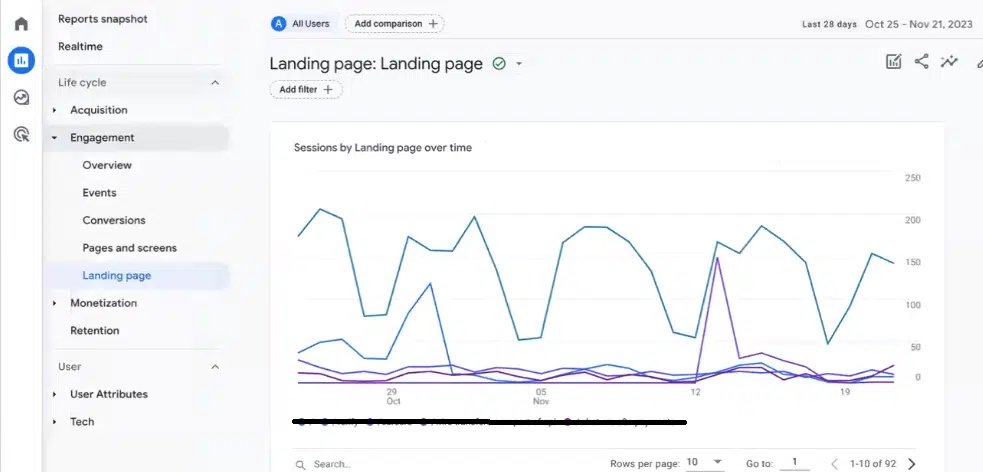
Following that, be certain to include a “Conversion” column in the report and clearly define the primary conversion metric you wish to scrutinize – in this case, we are evaluating form submissions.
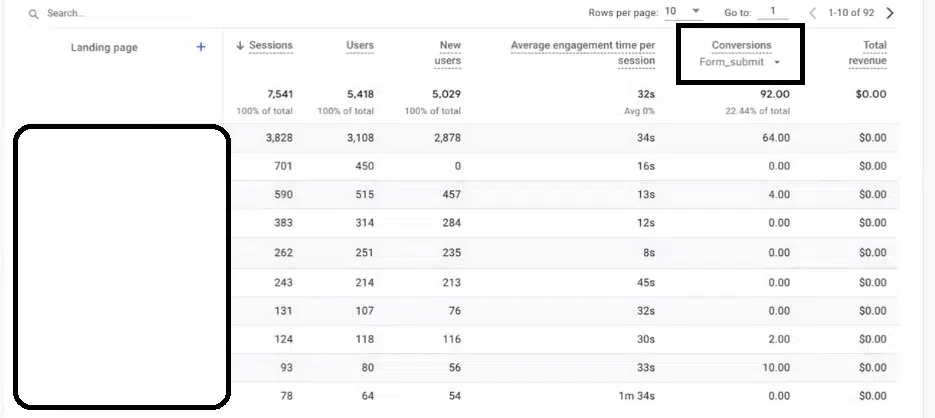
To gain additional insights, consider incorporating a “Source/Medium” dimension into the report for an added layer of information.
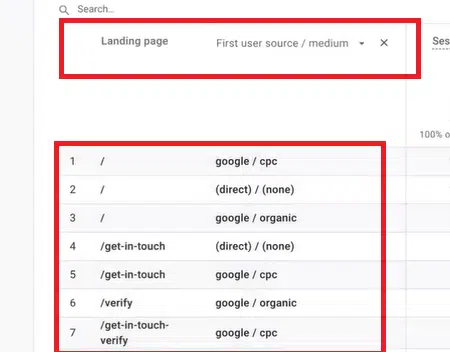
What does it show you?
This provides marketers with a concise overview of several opportunities:
Firstly, by sorting the data in descending order of sessions, you can readily identify the most frequently visited landing pages and assess which ones exhibit lower conversion rates. This should prompt a thorough examination of these pages to determine if they are optimized effectively for conversions, irrespective of their traffic source.
Secondly, sorting the data by the lowest number of sessions allows you to pinpoint pages with minimal traffic but a notable number of registered conversions. These pages may cater to niche audiences but can serve as valuable indicators of conversion-friendly properties and themes that warrant increased advertising investment.
By segmenting the data into landing page and channel performance, you gain valuable insights, including identifying channels that may require optimization for better ad-to-landing page performance.
How do you bake the insights into your strategy?
Firstly, it’s essential to prioritize the optimization of high-volume landing pages that attract significant ad spend and organic traffic but yield few conversions. These pages should be at the forefront of your optimization efforts for 2024. Additionally, consider collaborating with your product team to evaluate whether there are any market misalignments or competitive disadvantages hinted at by the performance of these pages.
Secondly, pay close attention to the lower-volume pages that excel at converting users. They hold valuable insights into what strategies are working effectively. These insights should guide your efforts to replicate their success or enhance their performance with additional resources.
Report 2: Content gap analysis
For this task, extensive manipulation of GA4 isn’t necessary. What’s crucial is having a clear understanding of the segments you intend to assess for your content audit. These segments could revolve around different aspects such as stages of the buying journey (top, middle, bottom), your primary products or services, or specific types of audiences and personas you want to target.
To determine the list size for your study, you can utilize the landing page report mentioned earlier. Download data for the top 20, 50, or 100 landing pages, depending on your preference and available resources. Once you have this data, commence the categorization process, sorting each landing page according to the specific segments you are focusing on. This approach will help you organize and analyze the landing pages effectively for your content audit.
What does it show you?
Upon completion of this process, you will gain a clear understanding of which segments require your attention in 2024. One valuable use case and potential outcome of this analysis is conducting a content gap assessment based on the stages of the buying journey. In this scenario, you can observe a distribution where blogs primarily occupy the top of the funnel, resources and About pages cater to the middle, and pages such as “Get in touch,” pricing, and comparison charts address the bottom of the funnel.
This report allows you to monitor the quantity of each page type you are creating and evaluate the balance of content representing each stage. For instance, you might discover that out of the 100 pieces of content on your website, 90 of them are thought leadership blog posts, while only 10 are Contact and bottom-funnel pages, leaving the middle of the funnel underrepresented.
A common issue I often encounter is brands overloading their content in the middle of the funnel, excessively focusing on themselves and their products. This imbalance can detract from top-of-funnel content, which plays a vital role in raising brand and product awareness and initiating users on their buying journey.
How do you bake the insights into your strategy?
Before taking action based on your content gap analysis findings, it’s essential to ensure alignment with your overall business goals. If, for instance, your business’s top priority is to raise awareness for a specific product, the analysis that highlights a lack of content for other products should be noted but not necessarily acted upon immediately.
Ideally, your analysis should reveal opportunities that directly contribute to your business’s primary objectives. Suppose you have a target audience, such as CFOs, and the analysis indicates that there’s room for additional content. In this case, you can take the following steps:
By aligning your content strategy with your business goals and addressing the specific audience and topic gaps, you can ensure that your efforts lead to meaningful outcomes and support your overarching objectives.
Report 3: Funnel exploration
This report enables you to select a top entry page, or multiple entry pages, and examine user behavior upon their arrival. One of the noteworthy use cases is to evaluate the conversion rates from blog posts, as illustrated in the example below.
Mechanics
To begin, navigate to “Explorations” and select “Funnel Exploration.”

Customize the steps of your funnel accordingly.
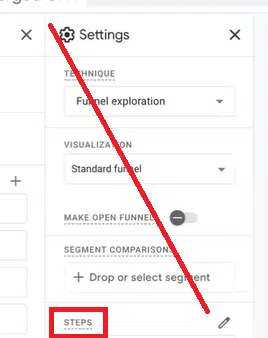
Next, configure your desired user journey. Below, I’ve specified that the initial page visited should include the “/resources” link, which corresponds to the client’s blog URL. Additionally, I’ve included a conversion event, marked as a gated lead form, to track completion at some point during the user’s visit.
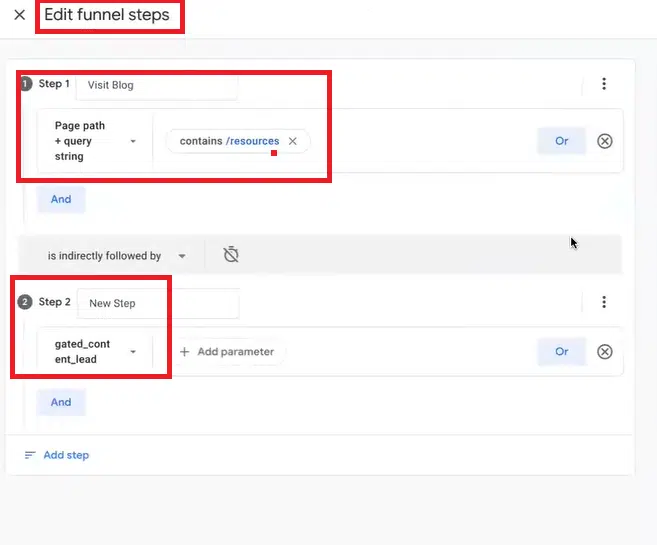
If you wish to gain insights into the channels responsible for driving users to your page, consider incorporating a dimension or breakdown related to the user’s initial traffic source. In this example, I was able to provide the client with some highly informative data.
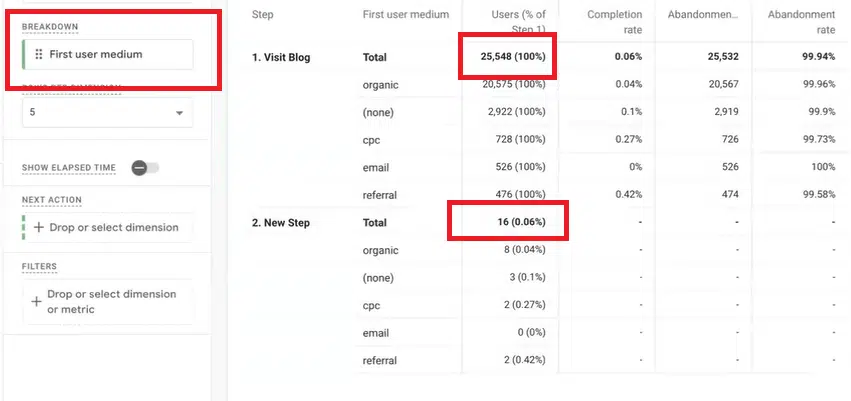
What does it show you?
Through this example, it becomes evident that the client effectively attracted visitors to their website via blog content, predominantly through organic sources. However, the blog content exhibited relatively low conversion rates.
This serves as a compelling call to action, urging a reconsideration of conversion strategies. It’s crucial to examine elements like the Call to Action (CTA) to ensure alignment with the type of content consumed by users.
How do you bake the insights into your strategy?
The example presented earlier demonstrates how to pinpoint substantial segments of your earned properties that are prime candidates for conversion optimization. However, the funnel exploration report can be applied in various ways.
One effective approach I recommend to clients is to commence with the homepage. Encourage them to outline the desired user journey and then generate the report to assess how many users are genuinely following that path.
If the observed conversion rate is lower than anticipated, consider implementing UX testing to delve into the reasons behind this discrepancy. This will enable you to devise proactive strategies for guiding users toward their intended destination.
Set your 2024 SEO course with these 3 valuable GA4 reports
In the long run, I remain convinced that GA4 will prove to be an invaluable platform, becoming an essential touchpoint for marketing teams. This is especially true if the platform can incorporate insights on SGE (Single Google Environment) as Google continues to expand its presence.
As we all strive to adhere to our 2024 resolutions, consider diving into GA4, making the most of its capabilities. If Google works towards making the platform more intuitive and consistent, becoming fluent in its tools and features will undoubtedly pay off in terms of the time and effort invested.
Original news from SearchEngineLand